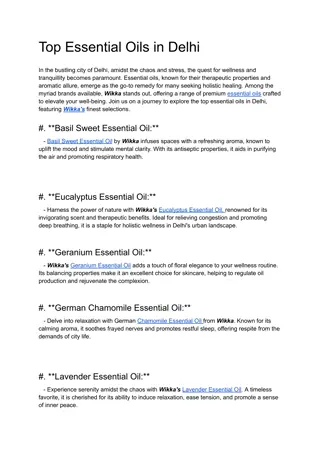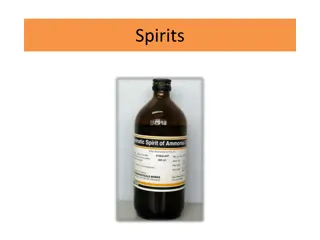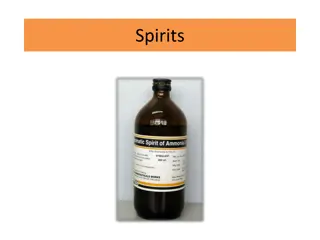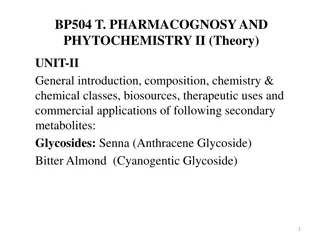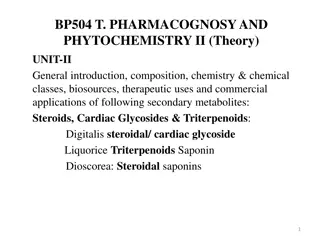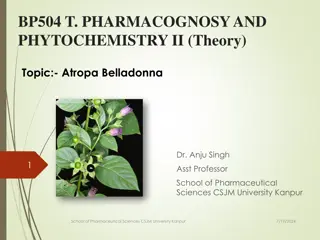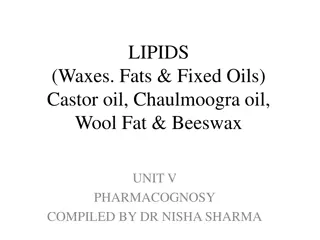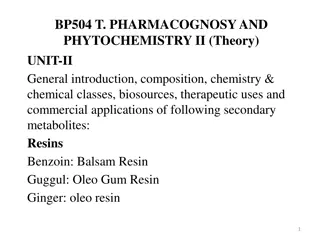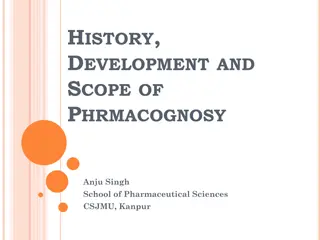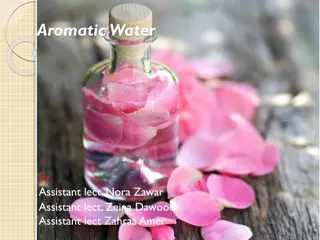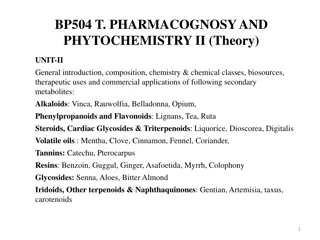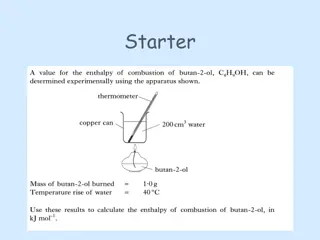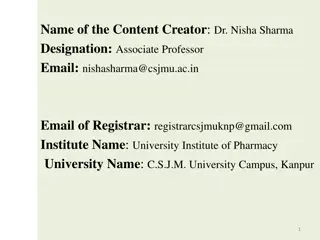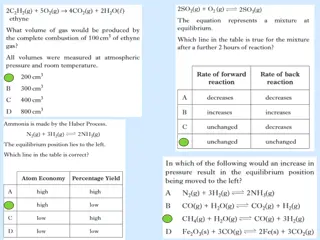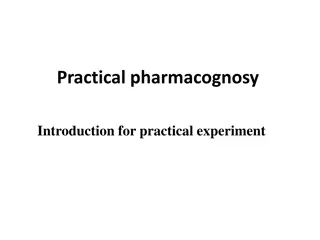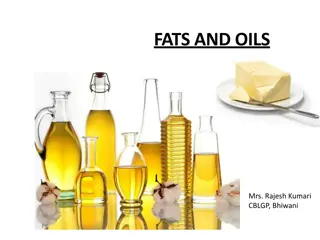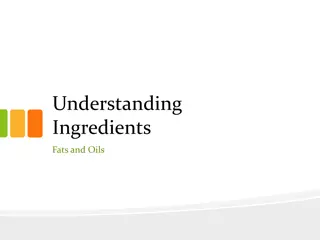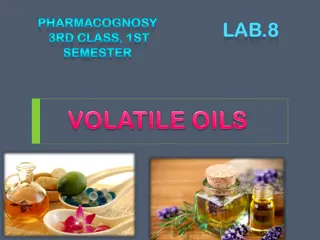Volatile Oils in Pharmacognosy and Phytochemistry: Composition, Chemistry, Uses
Volatile oils, also known as essential oils, are derived from terpenes and their oxygenated compounds. These oils possess characteristic odors and are extracted from plants through various methods like hydro-distillation and steam distillation. They are commonly used as flavoring agents, perfumes, and medicinal agents in pharmaceuticals, foods, beverages, and cosmetics, offering therapeutic benefits such as carminative, anthelmintic, diuretic, antiseptic, and more.
Download Presentation

Please find below an Image/Link to download the presentation.
The content on the website is provided AS IS for your information and personal use only. It may not be sold, licensed, or shared on other websites without obtaining consent from the author. Download presentation by click this link. If you encounter any issues during the download, it is possible that the publisher has removed the file from their server.
E N D
Presentation Transcript
BP504 T. PHARMACOGNOSY AND PHYTOCHEMISTRY II (Theory) UNIT-II General introduction, composition, chemistry & chemical classes, biosources, therapeutic uses and commercial applications of following secondary metabolites: Volatile oils : Mentha, Clove, Cinnamon, Fennel, Coriander 1
Volatile Oils Odorous, volatile principles of plant and animal sources are volatile oils. They evaporate on exposure to air at ordinary temp- "ethereal oils." They represent essence or active constituent of plant, or animal hence also known as "essential oils". Derived from terpenes & their oxygenated compounds Made up of isoprene units (C6H8) & usually mono-, sesqui and diterpenes with empirical formula C5H8, C10H16, C15H24 and C20H32 respectively. Soluble in alcohol, ether and other lipid solvents and practically insoluble in water. 2
Volatile Oils Possess characteristic odor, have high refractive index. Mostly optically active. Secreted in special structures such as duct, cell, schizogenous or lysigenous glands, trichomes, etc. Commonly found in Labiatae, Rutaceae, Piperaceae, Zingiberaceae, Umbelliferae, Myrtaceae and Lauraceae. Extracted by steam-distillation, solvent extraction or mechanical means like ecuelle & enfleurage techniques. 3
Volatile Oils Hydro-distillation method: water distillation, water and steam distillation, and steam distillation. Used for extraction of volatile oil from herbal drugs. Fresh material- subjected to hydro-distillation- leaf drugs. Air-dried parts extracted -steam distillation. Effleurage method : Used for extraction of delicate perfumes. Fresh flower petals- mechanically spread on layer of fatty material, allowed to imbibe & exhausted petals replaced by fresh material. Process continued till fatty layer is saturated with volatile principles, then extracted with lipid solvent. 4
Volatile Oils Ecuelle method: used for extraction of citrus oils, oil cells in rind ruptured mechanically using pointed projections by twisting raw material over them in clockwise direction either mechanically or manually. Liquid carbon dioxide supercritical fluid extraction: used to extract essential oils. Liquefied under pressure, it acts as a solvent reserving back to gaseous nature when pressure is reduced leaving no residue of solvent. 5
Uses of Volatile oils Flavouring and perfuming agents in pharmaceutical formulations, foods, beverages and cosmetics. Also used as medicinal agents - carminatives (umbelliferous fruits, cinnamon, etc.), anthelmintics (chinopodium), diuretic (Juniper), antiseptic (eucalyptus), counter-irritant (oil of wintergreen), local anaesthetic (clove), sedative (jatamansi), local irritant (turpentine) Citronella oil -insect repellant, lemon-grass oil for citral content, & for synthesis of vitamin A. Terpeneless oils are valuable perfuming and flavouring agents. 7
Uses of Volatile oils Terpeneless volatile oils - gets more price in perfumery industry, better specificity and stability. Processed by removing hydrocarbons and undesired components by fractional distillation and other techniques. Used in mfg. of high priced cosmetics and perfumes. During 1993-94 and 1994-95, India's total exports of volatile oil were Rs 3407.2 and Rs. 4426.3 lakhs, respectively. 8
Chemical tests for Volatile Oils 1. Thin section of the drug, + alcoholic solution of Sudan III. Red colour obtained by globules 2. Thin section of the drug, + drop of tincture alkane. Red color 10
Mentha Synonyms: Oleum mentha piperita, Colpermin, Mentha oil. Biological Source: Oil obtained by steam distillation- fresh flowering tops- plants Mentha piperita- family Labiatae. May be rectified. Mentha oil contains not < than 4.5 % & not > than 10% w/w of esters calculated as menthyl acetate, not < than 44% of free alcohols calculated as menthol and not < than 15% % not > than 32 % of ketone calculated as menthone 12
Mentha Mentha species : cultivated over the world. Grows wild in Europe, cultivated in Japan, England, France, Italy, USA, Bulgaria,USSR. In India, cultivated near Jammu and in Tarai region of Uttar Pradesh. temperature in between 15 to 25 C, altitude of 250 to 400 m Done by vegetative propagation method by using suckers Distance maintained b/w 2 rows is approx 50 to 60 cm. 13
Preparation of Mentha Oil Plants dried to 1/4th of their weight. Helps saving time req. for distillation, reduces cost of prodn. Direct drying under sun- loss of volatile oil No Fermentation during drying, affects quality & quantity Air-dried material charged into galvanised iron or mild-steel still. Still designed- has false perforated bottom. Steam under pressure, generated with the help of boiler, passed through the drug. Takes about 3 to 4 hrs for distillation. More than 80% of oil is distilled off during the first of distillation. 14
Preparation of Mentha Oil Distilln. should be completed carefully, as menthol of medicinal and commercial importance comes in latter part of distillation. Condenser- either Al or SS & be coiled, to se area of condensation. Distillate i.e. mentha oil- collected in separating can Mentha oil- insoluble in water & lighter than water, so keeps it floating in a separating can. Oil is decanted & filtered Average oil content of the herb is found to be 0.5 to 1% (v/w) approx. About 100 kg of the oil per hectare of the crop/year - satisfactory -commercial purposes. 15
Morphology & CC Color - Colorless to yellow. Odor - Characteristic & pleasant Taste - Pungent followed by cooling sensation. Solubility: Soluble in 70 % alcohol, ether and chloroform & insoluble in water. Chemical Constituents : Peppermint oil contains- chiefly l - menthol 70% in free & form of esters, depends on variety (like American, Japanese, Indian). American peppermint oil: contains 80% menthol, Japanese oil 70 - 90 % Other important constituents are menthone, menthofuran, jasmone, menthyl isovalerate, menthyl acetate & other terpene derivatives. 16
CC Other terpenes include l-limonene, isopulegone, cineole, pinene, camphene, etc. Jasmone and esters -responsible for pleasant flavor, Menthofuran causes resinification & acquires dirty smell Mentha oil obtained- steam distillation -Mentha arvensis var-piperascens (Japanese Mint), Commercially cultivated in U.P., Himachal Pradesh, Punjab, Haryana, Jammu and Kashmir and Central India. Contains about 80% l- menthol. Also cultivated in Japan, Brazil and California. Yield of oil is upto 1.2% v/w, as compared to 0.8 per cent v/w M. piperita. 17
CC Chemical Test: Few drops of peppermint oil +5 ml nitric acid solution (1 ml nitric acid to 300 ml of glacial acetic acid), heat on water bath. Within 5 min. liquid develops blue color, on further heating deepens & shows copper colored fluorescence & then gets golden yellow. 18
USES Used as carminative, stimulant, & flavouring agent. Has mild antiseptic prop. used in toothpaste, tooth powders, shaving creams, & different pharmaceutical dosage forms. Also consumed in the preparation of chewing gums, candies, jellies, perfumes and essences. Menthol is mfg in India by S. H. Kelkar and Co., Bhavna Chemicals, Procter and Gamble Ltd. & several others. India produces about 500 tonnes of menthol annually. Both mentha oil and menthol have calcium channel blocking activity causing spasmolytic and smooth muscle relaxant effects, and hence useful in irritable bowel syndrome. 19
USES Show better pharmacokinetic profile- with enteric coated capsules for release in large intestine. Muscle relaxant activity- reduce spasm during endoscopy of colon. Emulsified oil injected through biopsy channel of the endoscope. Digestant activity by stimulating bile flow. Supported by flavonoid pigments of leaf. Azulene from the leaf - anti-inflammatory and anti- ulcer in activity. Nasal decogestant effect, menthol is considered by U.S.F.D.A. as generally regarded as safe (GRAS). Used for inhalation in steam, topical products and lozenges for antitussive effects. 20
Trade Peppermint oil and menthol exported from India The export values during 1994-95- Rs 2890 lakhs & Rs 623 lakhs for menthol and peppermint oil respectively. India largest producer and exporter of mentha oil and its derivatives. The total production is expected to rise 35-40 per cent to 48,000 tonnes to 50,000 tonnes (2019) Herb grown in UP is in huge demand by oral care, pharmaceutical, perfumery and confectionery sectors. 21
Substitutes and Adulterants Many species of Mentha contain oil. these oils are de-mentholized & used as adulterants to the drug. Storage : well-filled & air-tight, protected from light, & in cool place. Darkens & becomes viscous on storage. If cooled, separation of menthol crystals occurs. Other species of Mentha such as M. Iongifolia, M. roundifolia and M. spicata (spearmint) also yield volatile oils for flavoring purpose. 22
CLOVE Synonyms: Caryophyllum, Clove flower, Clove buds. Biological Source: dried flower buds of Eugenia caryophyllus, family Myrtaceae. contains not < than 7.0% (w/w) of eugenol on dried basis. Geographical Source: Indigenous to Amboyna and Molucca islands. Cultivated in Zanzibar, Pemba, Penang, Madagascar, Caribbean islands, Sri Lanka and India. In India, in Nilgiri, Tenkasi-hills and in Kanyakumari district of Tamil Nadu state. Also cultivated in Kottayam and Quilon districts of Kerala. 23
CLOVE Annual rainfall in the range of 150 - 250 cm From sea level upto 900 m. It is propagated by seed germination. The seeds are sown from August to October. Nursery beds at a distance of 10 cm. Takes 4 to 5 weeks for seed germination. After 6 months, transplanted to pots where allowed to grow for a year. Again transferred to field & provided with the shade in initial stages of growth. Clove also be grown with arecanut, coconut or nutmeg 24
CLOVE Bears after 7 - 8 years & satisfactory yield/ hectare of drug achieved after 15 - 20 yrs of growth. Normal condition of soil, clove tree -3 kg of the drug. Cloves handpicked/ collected by beating with bamboos. When cloves start changing their colour from green to slightly pink. Platform ladders are used for collection. Dried in the sun & freed from foreign material & graded. Cloves on drying- perfectly crimson or brownish-black 25
CLOVE Morphology: Color-Crimson to dark brown. Odor- Slightly aromatic Taste - Pungent & aromatic followed by numbness Size - About 10 to 17.5 mm (L), 4 mm (W), & 2 mm thick. Shape - Hypanthium is surmounted with 4 thick acute divergent sepals surrounded by dome shaped corolla. The corolla consists of unexpanded membranous petals with several stamens and single stiff prominent style. Cloves are heavier than water. 26
CLOVE Contains: 15 to 20% of volatile oil; 10% to 13% of tannin (gallotannic acid), resin, chromone and eugenin. Volatile oil of the drug contains eugenol (70 to 90%), eugenol acetate, Caryophyllenes & small quantities of esters, ketones and alcohols. Oil of clove: colourless to pale yellow in color. Becomes thick and darker in color on storage. Has specific gravity of 1.038 - 1.06, refractive index 1.527 to 1.535 and boils at 250 C. Chemical Test : TS + strong KOH sol. Results in needle shaped crystals of potassium eugenate. 27
CLOVE Uses: As a dental analgesic, carminative, stimulant, flavoring agent, an aromatic and antiseptic. It is also used in the preparation of cigarettes. Oil used in perfumery & mfg of vanillin. Adulterants 1. Mother cloves: dark brown, ovate ripened fruits of clove tree. Slightly aromatic & contain starch. inferior in volatile oil content. 2. Blown cloves: are expanded flowers of the clove tree. Stamens generally get detached. Contain volatile oil & similar in color Volatile oil content less compared to authentic drug. 3. Clove stalks: To adulterate powdered cloves & detected by presence of isodiametric sclerieds and prisms of calcium oxalate. Their ash value and crude fibre contents are also high 28
Uses of CLOVE The authentic cloves: not contain > than 5 % of stalks to pass the pharmacopoeial limit. Due to similarity in color, odor & taste, clove stalks are mixed with the cloves. Clove stalks contain only 5% oil. 4. Exhausted cloves: cloves from which oil has been extracted by distillation. Are dark in color, more shrunken & when pressed with finger nails, NO presence of oil. They float on water. Storage: stored in air-tight containers in cool and dry places. 29


